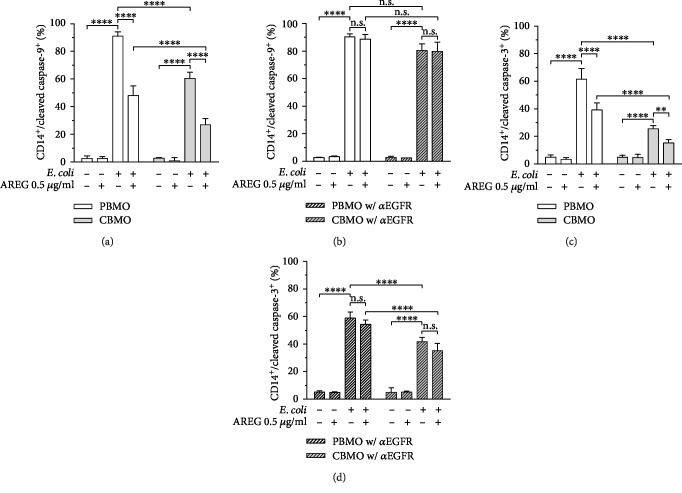Figure 4.
Intracellular levels of cleaved caspase-9 and cleaved caspase-3 in PBMO and CMBO in response to infection, AREG stimulation, and inhibition of EGFR. Isolated monocytes were infected with E. coli, extracellular bacteria were removed, and the cells were cultivated for 24 h in medium supplemented with antibiotics. 1 h prior to infection, AREG stimulation and EGFR inhibitor treatment were started and maintained during the entire cultivation period. Detection was performed by flow cytometry. (a) Cleaved caspase-9 in PBMO and CBMO in response to infection and AREG stimulation. In both PBMO and CBMO, cleaved caspase-9 levels were significantly increased in response to E. coli infection, whereas AREG stimulation in turn leads to a decrease in cleaved caspase-9 levels (n = 5). (b) Effect of EGFR inhibition on cleaved caspase-9 levels in PBMO and CBMO in response to infection and AREG stimulation. EGFR inhibition abolishes the AREG-mediated decrease in cleaved caspase-9 in both infected PBMO and CBMO (n = 4). (c) Cleaved caspase-3 in PBMO and CBMO in response to infection and AREG stimulation. In both groups, cleaved caspase-9 levels were significantly increased in response to E. coli infection, while AREG stimulation diminishes the effect (n = 5). (d) Effect of EGFR inhibition on cleaved caspase-3 in PBMO and CBMO in response to infection and AREG stimulation. In both infected PBMO and CBMO, EGFR inhibition offsets the AREG-mediated decrease in cleaved caspase-3 levels (n = 4). Data are shown as means + SD. Statistical significance was analyzed using two-way ANOVA with Bonferroni's multiple comparisons test. n.s.: not significant. ∗∗p < 0.01; ∗∗∗∗p < 0.001.

